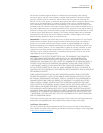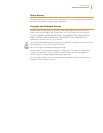
Kindle User’s Guide 17
Appendix A Product Information
Turn Off Wireless When Flying
To prevent possible interference with aircraft systems, the U.S. Federal Aviation Administration
regulations and many other aviation agencies require you to have permission from a
crewmember to use your device’s wireless service.
Using Your Kindle Around Other Electronic Devices
Kindle generates, uses, and can radiate radio frequency (RF) energy and, if not used in
accordance with its instructions, may cause interference to radio communications and
electronic equipment. External RF signals may affect improperly installed or inadequately
shielded electronic operating systems, entertainment systems, and personal medical devices.
While most modern electronic equipment is shielded from external RF signals, if in doubt,
check with the manufacturer. For personal medical devices (such as pacemakers and hearing
aids), consult with your physician or the manufacturer to determine if they are adequately
shielded from external RF signals.
Steps to Minimize Interference
If your Kindle does cause interference to radio or television reception (which you can
determine by turning your Kindle off and on), you can try to correct the interference by one
or more of the following measures: increase the separation between the radio or television
and your Kindle; connect equipment and receivers to different outlets; or consult the radio or
television manufacturer or an experienced radio/TV technician for help.
Watch for Signs
There are some places where RF signals could constitute a hazard, such as health care
facilities, and construction sites.
If you are not sure, look around for signs indicating that two-way radios or cell phones should
be turned off.
FCC Compliance Statement for Model Number D01100,
FCC ID: ZEG-0725
The device complies with part 15 of the FCC rules. Operation is subject to the following two
conditions: (1) The device may not cause harmful interference; and (2) the device must accept
any interference received, including interference that may cause undesired operation.
The device has been tested and found to comply with the limits for a Class B digital device,
pursuant to part 15 of the FCC rules. These limits are designed to provide reasonable
protection against harmful interference in a residential installation. However, there is no
guarantee that interference will not occur in a particular installation. Changes or modifications
not expressly approved by the party responsible for compliance could void the user’s
authority to operate the equipment.
The device meets the FCC Radio Frequency Emission Guidelines and is certified with the
FCC as the FCC ID number found on the back of the device. Changes or modifications not
expressly approved by the party responsible for compliance could void the user’s authority to
operate the equipment.


















